A Study of the Effect of Brake Pad Scorching on Tribology and Airborne Particle Emissions
Abstract
1. Introduction
2. Experimental Methodology
2.1. Car and Brake System
2.2. Materials
2.3. Pin-on-Disc Tribometer
2.4. Brake Dyno Bench
3. Results
3.1. PoD Tests
3.2. Characterization of Worn Surfaces
3.3. Dyno Bench
4. Discussion
5. Conclusions
- The tribological performance in terms of CoF and wear for the scorched and extra scorched surfaces are comparable. The rectified pad surface exhibits a lower wear.
- The level of airborne particle emissions during the PoD tests are qualitatively in line with the inertia dyno bench test for about the first forty brake events (195 s); thereafter, the airborne particle emissions are higher for the scorched pads. It can be concluded from these results that the scorched pads result in higher levels of total PN and PM emissions.
Author Contributions
Funding
Conflicts of Interest
References
- Amato, F. Non-Exhaust Emissions: An Urban Air Quality Problem for Public Health; Academic Press ELSEVIER: San Diego, CA, USA, 2018. [Google Scholar]
- Alemani, M. Particle Emissions from Car Brakes: The Influence of Contact Conditions on the Pad-to-Rotor Interface. Ph.D. Thesis, KTH Royal Institute of Technology, Stockholm, Sweden, 2017. [Google Scholar]
- European Environment Agency (EEA). European Union emission inventory report 1990–2017 under the UNECE Convention on Long-range Transboundary Air Pollution (LRTAP); European Environment Agency: Copenhagen, Demark, 2019; Available online: https://www.eea.europa.eu//publications/european-union-emissions-inventory-report-2017 (accessed on 30 March 2020).
- Grigoratos, T.; Martini, G. Brake wear particle emissions: A review. Environ. Sci. Pollut. Res. 2014, 22, 2491–2504. [Google Scholar] [CrossRef] [PubMed]
- Timmers, V.R.; Achten, P.A. Non-exhaust PM emissions from electric vehicles. Atmos. Environ. 2016, 134, 10–17. [Google Scholar] [CrossRef]
- Non-Exhaust Emissions from Road Traffic; Air Quality Expert Group, Department for Environment, Food and Rural Affairs (Defra): London, UK, 2019.
- Doyle, A.; Muneer, T. Traction energy and battery performance modelling. In Electric Vehicles: Prospects and Challenges; Muneer, T., Kolhe, M.L., Doyle, A., Eds.; Elsevier: Amsterdam, The Netherlands, 2017; pp. 93–124. ISBN 9780128030219. [Google Scholar]
- Wahlström, J.; Söderberg, A.; Olander, L.; Jansson, A.; Olofsson, U. A pin-on-disc simulation of airborne wear particles from disc brakes. Wear 2010, 268, 763–769. [Google Scholar] [CrossRef]
- Sanders, P.G.; Xu, N.; Dalka, T.M.; Maricq, M.M. Airborne brake wear debris: Size distributions, composition, and a comparison of dynamometer and vehicle tests. Environ. Sci. Technol. 2003, 37, 4060–4069. [Google Scholar] [CrossRef] [PubMed]
- Perricone, G.; Wahlström, J.; Olofsson, U. Towards a test stand for standardized measurements of the brake emissions. Proc. Inst. Mech. Eng. Part D J. Automob. Eng. 2016, 230, 1521–1528. [Google Scholar] [CrossRef]
- Hagen, F.H.F.Z.; Mathissen, M.; Grabiec, T.; Hennicke, T.; Rettig, M.; Grochowicz, J.; Vogt, R.; Benter, T. Study of brake wear particle emissions: Impact of braking and cruising conditions. Environ. Sci. Technol. 2019, 53, 5143–5150. [Google Scholar] [CrossRef] [PubMed]
- Mamakos, A.; Arndt, M.; Hesse, D.; Augsburg, K. Physical characterization of brake-wear particles in a PM10 dilution tunnel. Atmosphere 2019, 10, 639. [Google Scholar] [CrossRef]
- Mathissen, M.; Grigoratos, T.; Lähde, T.; Vogt, R. Brake wear particle emissions of a passenger car measured on a chassis dynamometer. Atmosphere 2019, 10, 556. [Google Scholar] [CrossRef]
- Wahlström, J.; Olofsson, U. A field study of airborne particle emissions from automotive disc brakes. Proc. Inst. Mech. Eng. Part D J. Automob. Eng. 2014, 229, 747–757. [Google Scholar] [CrossRef]
- Wahlström, J.; Lyu, Y.; Matjeka, V.; Söderberg, A. A pin-on-disc tribometer study of disc brake contact pairs with respect to wear and airborne particle emissions. Wear 2017, 384, 124–130. [Google Scholar] [CrossRef]
- Chan, D.; Stachowiak, G.W. Review of automotive brake friction materials. Proc. Inst. Mech. Eng. Part D J. Automob. Eng. 2004, 218, 953–966. [Google Scholar] [CrossRef]
- Ertan, R.; Yavuz, N. An experimental study on the effects of manufacturing parameters on the tribological properties of brake lining materials. Wear 2010, 268, 1524–1532. [Google Scholar] [CrossRef]
- Matějka, V.; Metinöz, I.; Wahlström, J.; Alemani, M.; Perricone, G. On the running-in of brake pads and discs for dyno bench tests. Tribol. Int. 2017, 115, 424–431. [Google Scholar] [CrossRef]
- Perricone, G.; Matějka, V.; Alemani, M.; Wahlström, J.; Olofsson, U. A Test stand study on the volatile emissions of a passenger car brake assembly. Atmosphere 2019, 10, 263. [Google Scholar] [CrossRef]
- Ma, J.; Olofsson, U.; Lyu, Y.; Wahlström, J.; Åström, A.H.; Tu, M. A comparison of airborne particles generated from disk brake contacts: Induction versus frictional heating. Tribol. Lett. 2020, 68, 1–13. [Google Scholar] [CrossRef]
- Dante, R.C. Handbook of Friction Materials and Their Application; Elsevier: Amsterdam, The Netherlands, 2016. [Google Scholar]
- Riva, G.; Wahlström, J.; Alemani, M.; Olofsson, U. A CFD study of a pin-on-disc tribometer setup focusing on airborne particle sampling efficiency. In Proceedings of the ECOTRIB Conference Proceedings, 6th European COnference on TRIBology, Ljubljana, Slovenia, 7–9 June 2017. [Google Scholar]
- Perricone, G.; Alemani, M.; Wahlström, J.; Olofsson, U. A proposed driving cycle for brake emissions investigation for test stand. Proc. Inst. Mech. Eng. Part D J. Automob. Eng. 2019, 234, 122–135. [Google Scholar] [CrossRef]
- Riva, G.; Perricone, G.; Wahlström, J. A multi-scale simulation approach to investigate local contact temperatures for commercial Cu-full and Cu-free brake pads. Lubricants 2019, 7, 80. [Google Scholar] [CrossRef]
- Wahlström, J. A factorial design to numerically study the effects of brake pad properties on friction and wear emissions. Adv. Tribol. 2016, 2016, 1–10. [Google Scholar] [CrossRef]


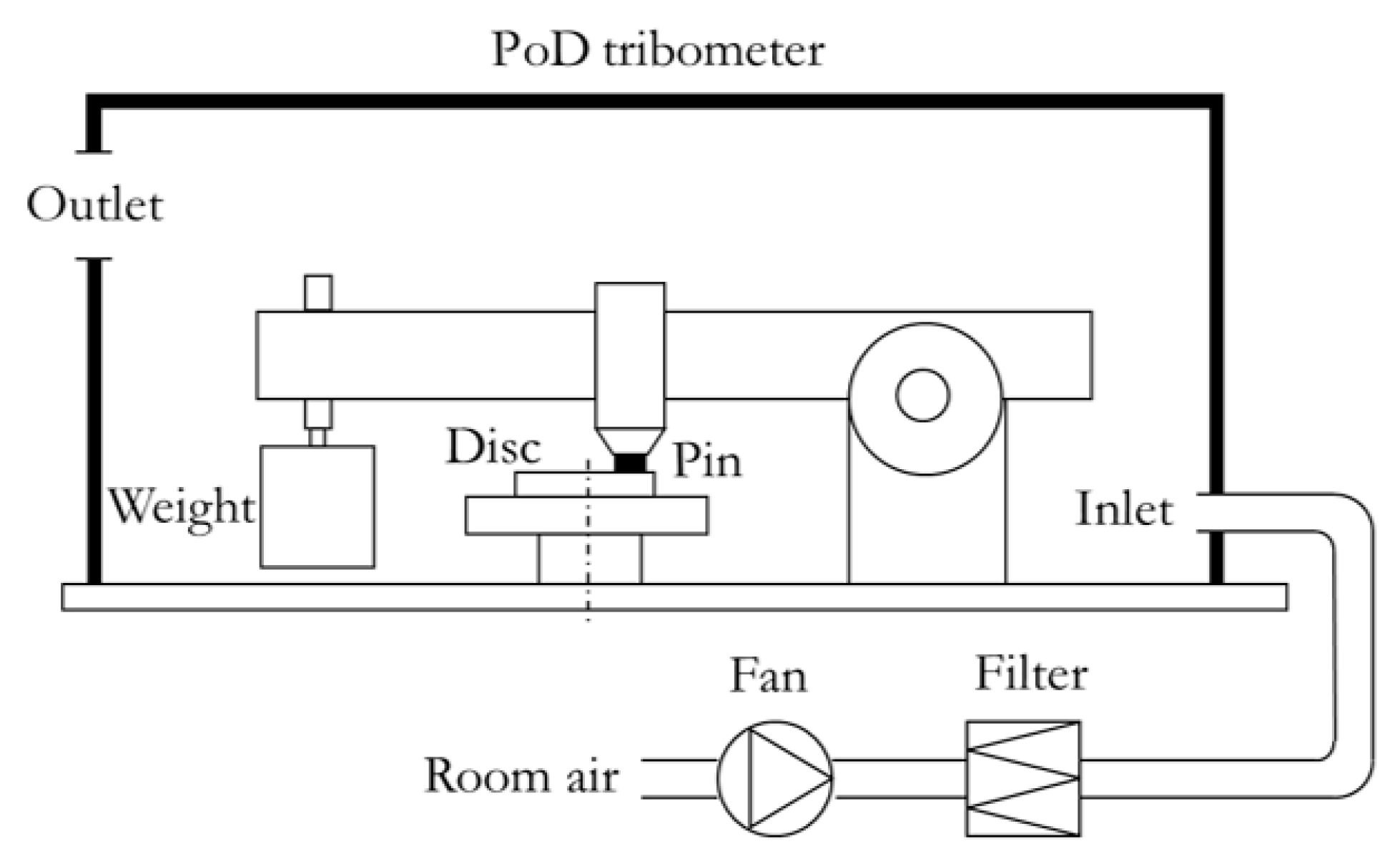
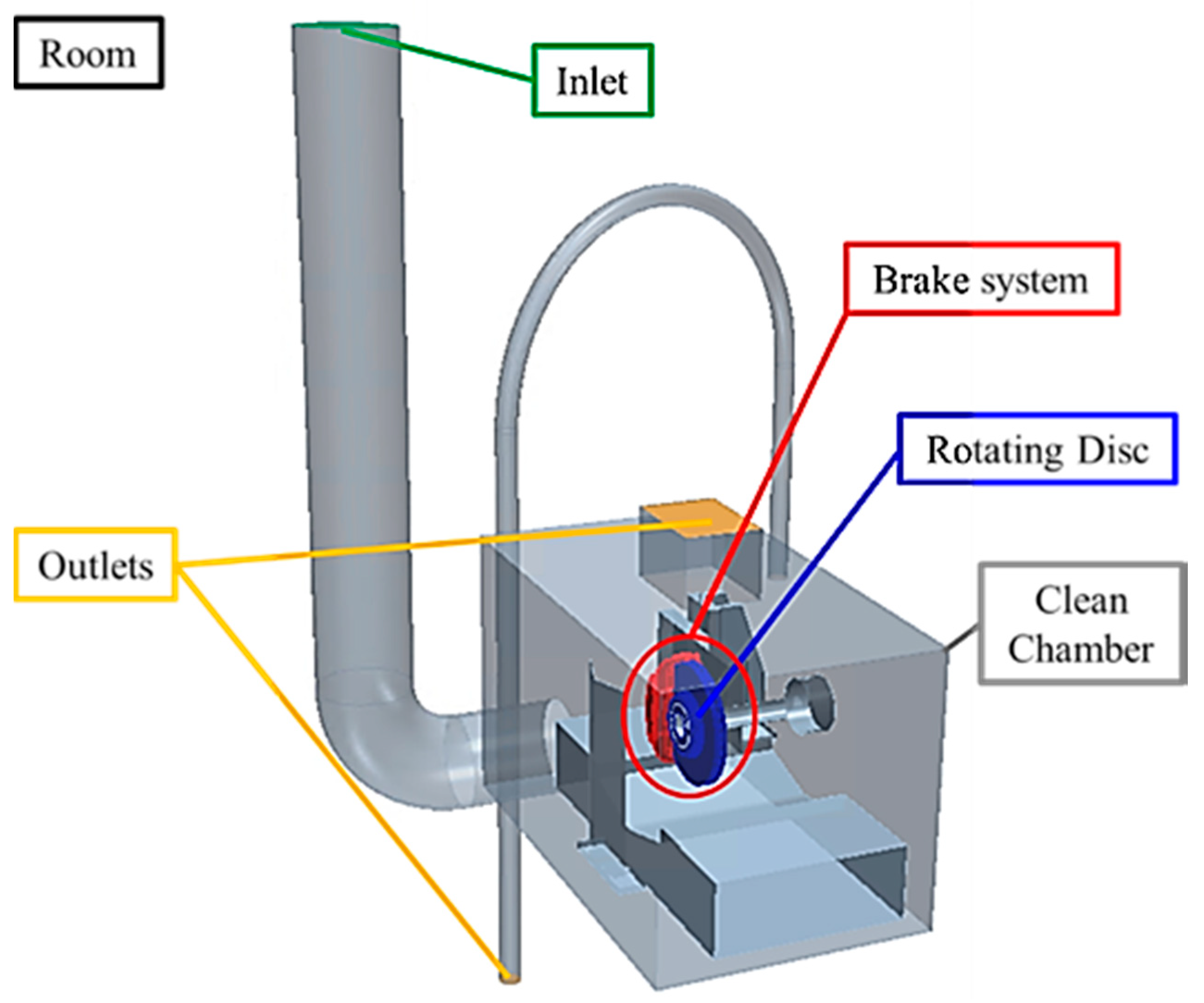

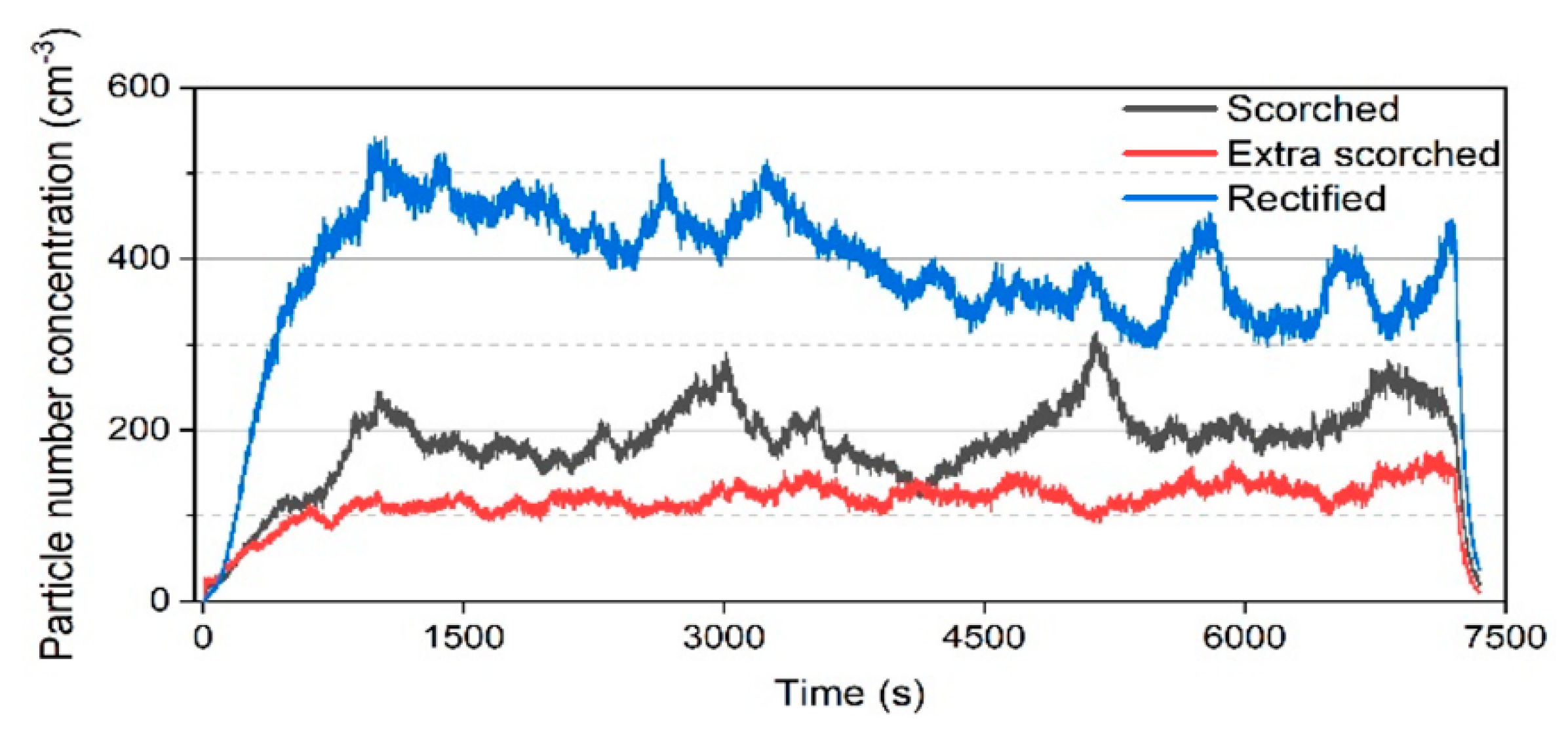
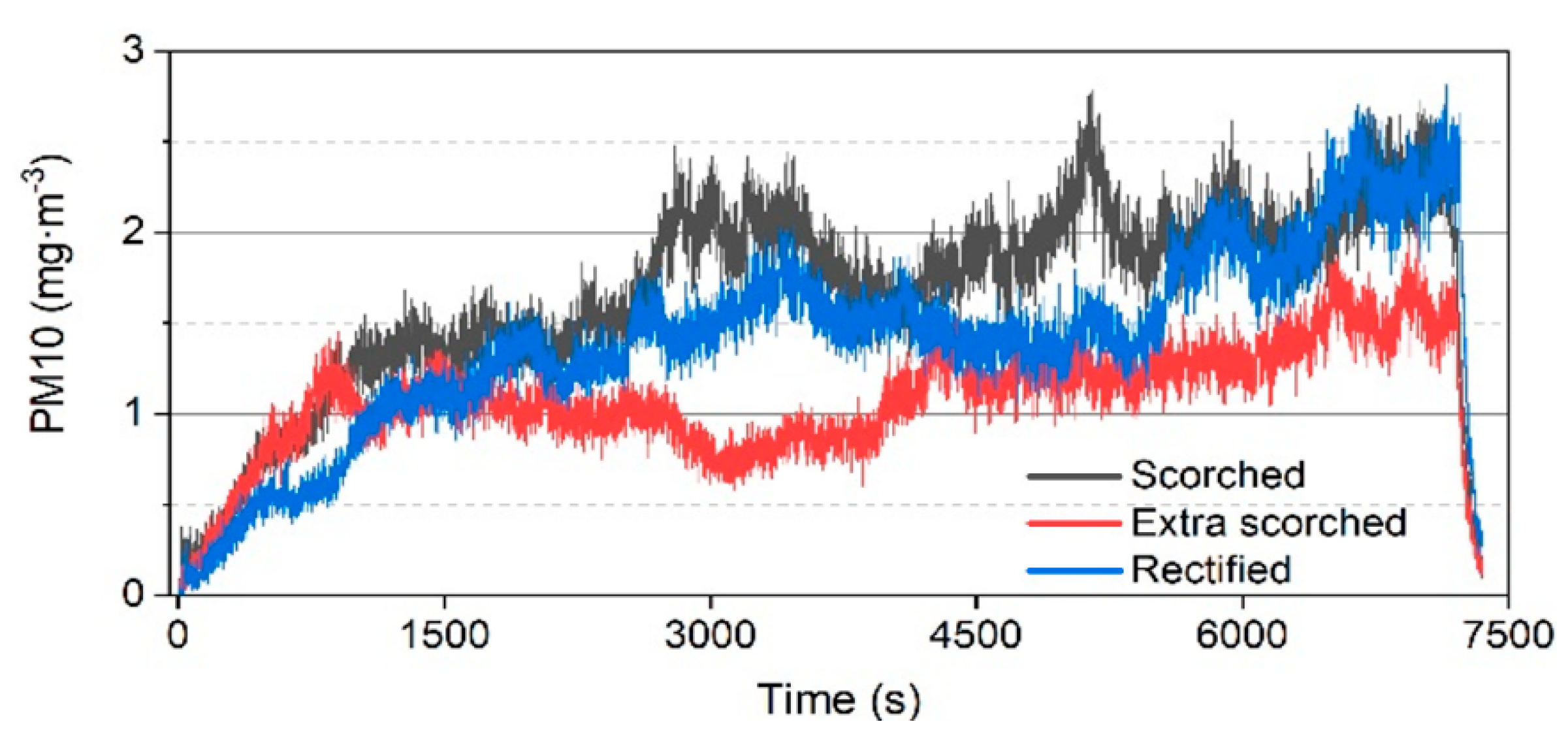

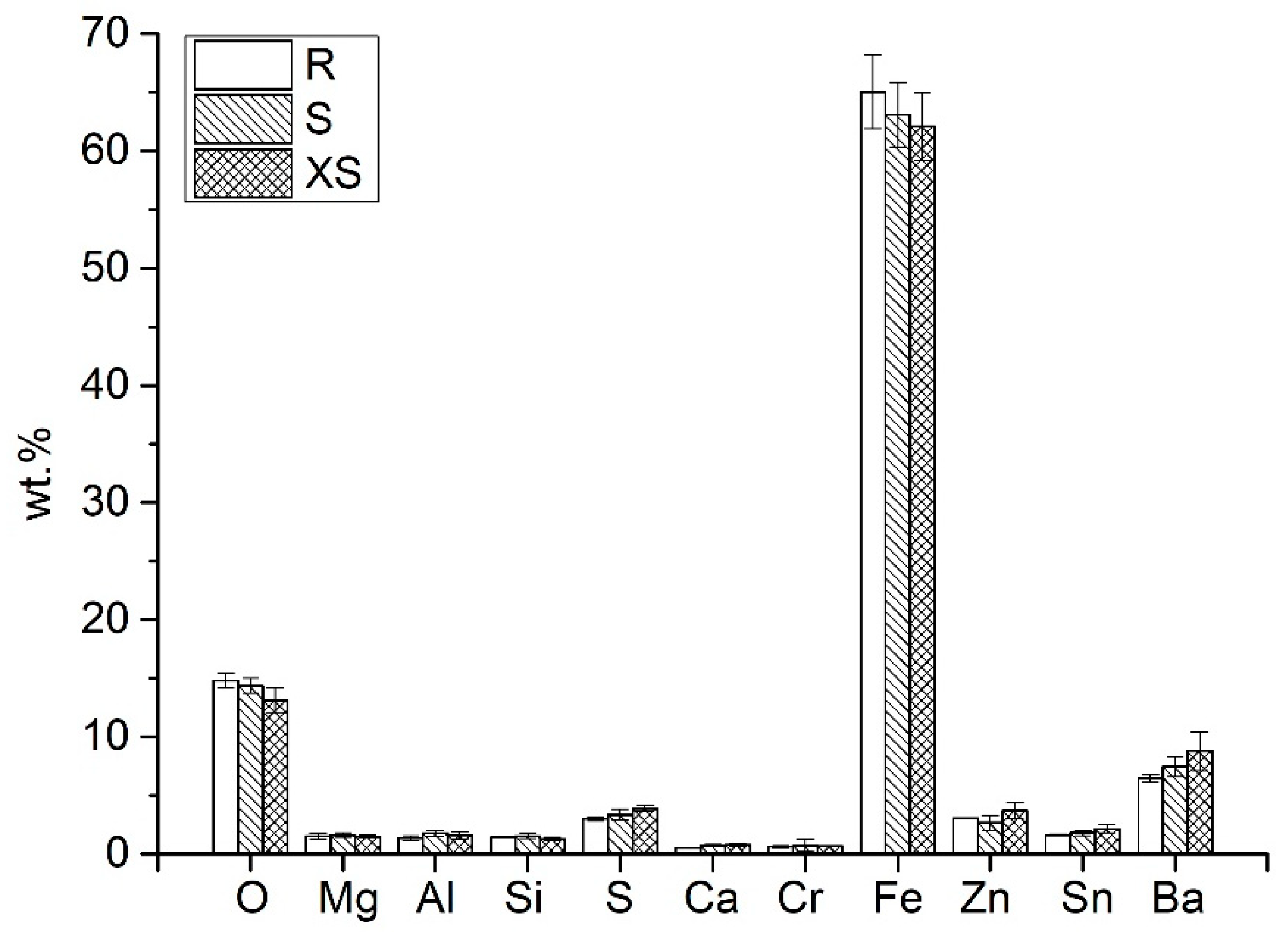
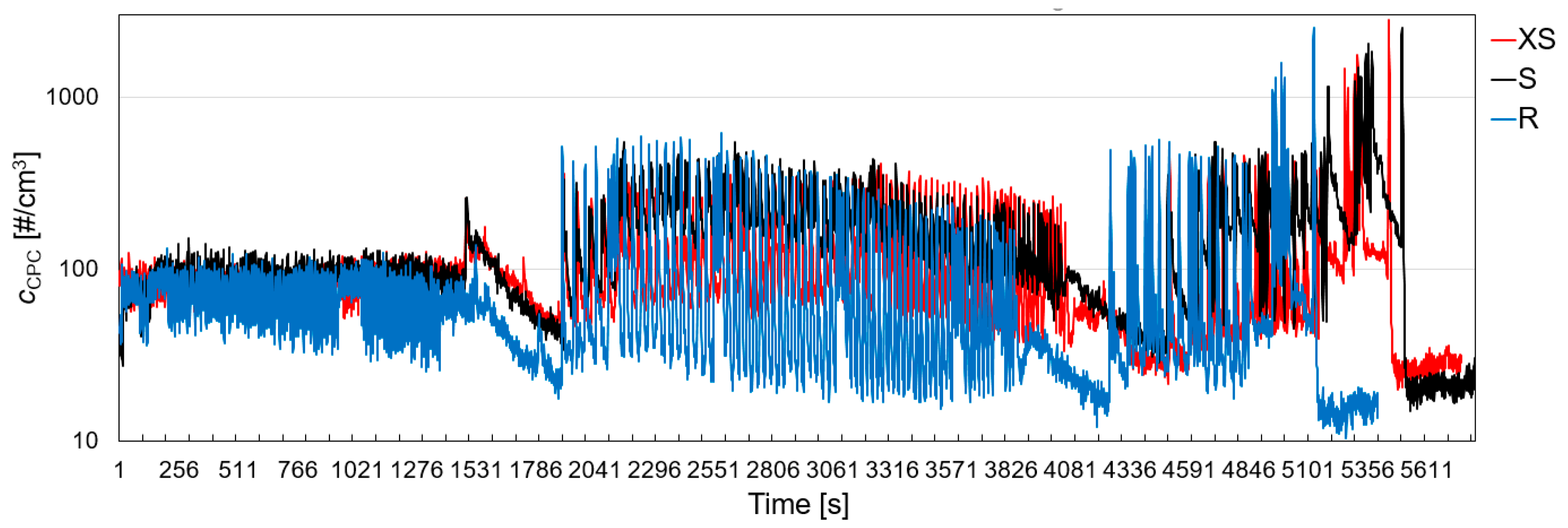
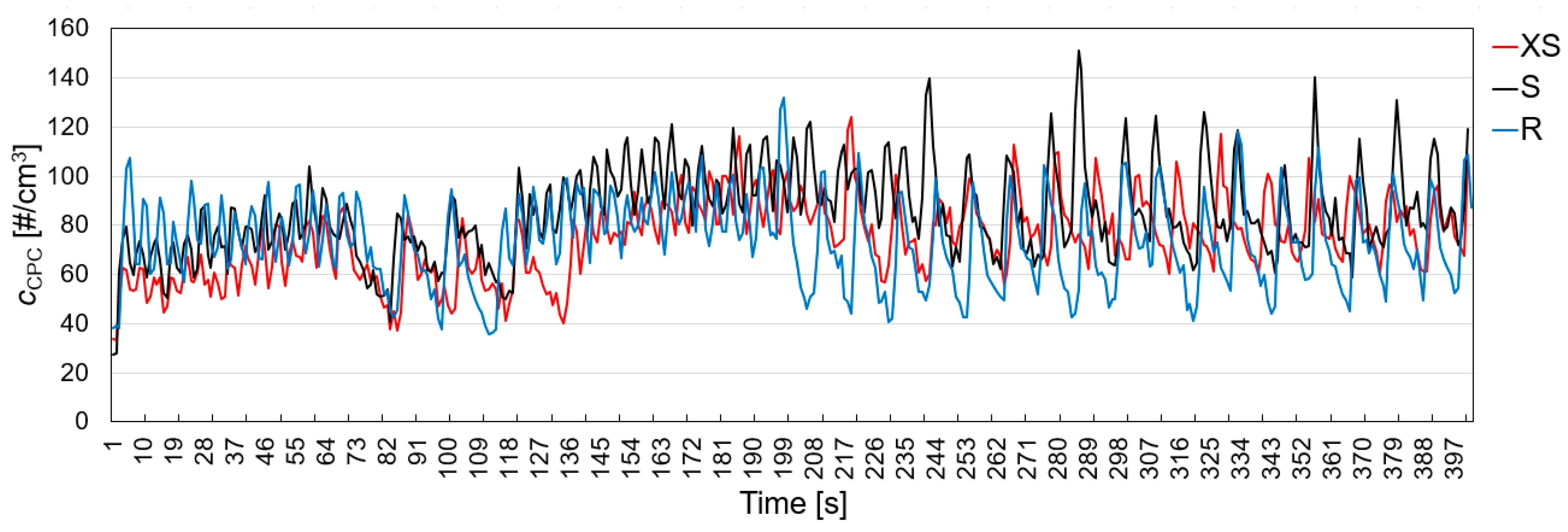
| Property | Value |
|---|---|
| Wheel radius | 361 mm |
| Rotor outer radius | 171 mm |
| Rotor inner radius | 92.2 mm |
| Rotor effective radius | 136 mm |
| Pad surface area | 7507 mm2 |
| Cylinder diameters | 4 × 22 mm |
| Element | wt.% | Element | wt.% |
|---|---|---|---|
| Fe | 13.7 | S | 9.1 |
| Ba | 20.2 | Sn | 7.7 |
| Zn | 8.4 | Ca | 3.2 |
| Mg | 7.5 | Cr | 2.6 |
| Al | 7.1 | O | 16.2 |
| Si | 4.3 | ||
| N | Section | Initial Speed (km/h) | Final Speed (km/h) | Initial Rotor Brake Temperature (°C) | Braking Deceleration (g) | Number of Stops in Present Test (N) |
|---|---|---|---|---|---|---|
| 5′ Cleaning | ||||||
| 1.1 | 25 J/kg specific energy | 36 | 26 | 70 | 0.16 | 2 |
| 1.2 | 36 | 26 | 90 | 0.16 | 18 | |
| 1.3 | 36 | 26 | 110 | 0.16 | 83 | |
| 1.4 | 36 | 26 | 130 | 0.16 | 56 | |
| 1.5 | 36 | 26 | 150 | 0.16 | 24 | |
| 1.6 | 36 | 26 | 170 | 0.16 | 8 | |
| 2.1 | 75 J/kg specific energy | 52 | 28 | 70 | 0.23 | 5 |
| 2.2 | 52 | 28 | 90 | 0.23 | 16 | |
| 2.3 | 52 | 28 | 110 | 0.23 | 22 | |
| 2.4 | 52 | 28 | 130 | 0.23 | 25 | |
| 2.5 | 52 | 28 | 150 | 0.23 | 12 | |
| 2.6 | 52 | 28 | 170 | 0.23 | 8 | |
| 3.1 | 125 J/kg specific energy | 57 | 5 | 70 | 0.25 | 2 |
| 3.2 | 57 | 5 | 90 | 0.25 | 3 | |
| 3.3 | 57 | 5 | 110 | 0.25 | 6 | |
| 3.4 | 57 | 5 | 130 | 0.25 | 8 | |
| 3.5 | 57 | 5 | 150 | 0.25 | 1 | |
| 4.1 | 175 J/kg specific energy | 70 | 17 | 110 | 0.31 | 1 |
| 4.2 | 70 | 17 | 130 | 0.31 | 2 | |
| 4.3 | 70 | 17 | 170 | 0.31 | 1 | |
| 5.1 | 225 J/kg specific energy | 79 | 20 | 110 | 0.24 | 1 |
| 5′ Cleaning |
| Rectified | Scorched | Extra-Scorched | |
|---|---|---|---|
| CoF | 0.47 ± 0.03 | 0.47 ± 0.01 | 0.44 ± 0.02 |
| cOPS (cm−3) | 349 ± 60 | 246 ± 91 | 139 ± 11 |
| cELPI+ (mg·m−3) | 2.02 ± 0.29 | 2.03 ± 0.31 | 1.44 ± 0.15 |
| Qair (m3·h−1) | 7.56 ± 0.17 | 7.71 ± 0.12 | 7.63 ± 0.08 |
| Δmpin (mg) | 70.2 ± 9.3 | 86.5 ± 15.1 | 87.9 ± 9.8 |
| Δmdisc (mg) | 69.5 ± 9.7 | 74.6 ± 12.3 | 76.6 ± 9.5 |
| Rectified | Scorched | Extra-Scorched | |
|---|---|---|---|
| cELPI+ (105·cm−3) | 8.8 ± 2.4 | 9.8 ± 2.5 | 12.8 ± 3.2 |
| cCPC (105·cm−3) | 5.6 ± 1.5 | 6.5 ± 2.2 | 7.3 ± 2.2 |
| PM (g) | 0.34 ± 0.05 | 0.34 ± 0.08 | 0.44 ± 0.06 |
| Δmpad (g) | 5.7 ± 0.7 | 7.6 ± 0.3 | 8.6 ± 0.6 |
© 2020 by the authors. Licensee MDPI, Basel, Switzerland. This article is an open access article distributed under the terms and conditions of the Creative Commons Attribution (CC BY) license (http://creativecommons.org/licenses/by/4.0/).
Share and Cite
Wahlström, J.; Leonardi, M.; Tu, M.; Lyu, Y.; Perricone, G.; Gialanella, S.; Olofsson, U. A Study of the Effect of Brake Pad Scorching on Tribology and Airborne Particle Emissions. Atmosphere 2020, 11, 488. https://doi.org/10.3390/atmos11050488
Wahlström J, Leonardi M, Tu M, Lyu Y, Perricone G, Gialanella S, Olofsson U. A Study of the Effect of Brake Pad Scorching on Tribology and Airborne Particle Emissions. Atmosphere. 2020; 11(5):488. https://doi.org/10.3390/atmos11050488
Chicago/Turabian StyleWahlström, Jens, Mara Leonardi, Minghui Tu, Yezhe Lyu, Guido Perricone, Stefano Gialanella, and Ulf Olofsson. 2020. "A Study of the Effect of Brake Pad Scorching on Tribology and Airborne Particle Emissions" Atmosphere 11, no. 5: 488. https://doi.org/10.3390/atmos11050488
APA StyleWahlström, J., Leonardi, M., Tu, M., Lyu, Y., Perricone, G., Gialanella, S., & Olofsson, U. (2020). A Study of the Effect of Brake Pad Scorching on Tribology and Airborne Particle Emissions. Atmosphere, 11(5), 488. https://doi.org/10.3390/atmos11050488







